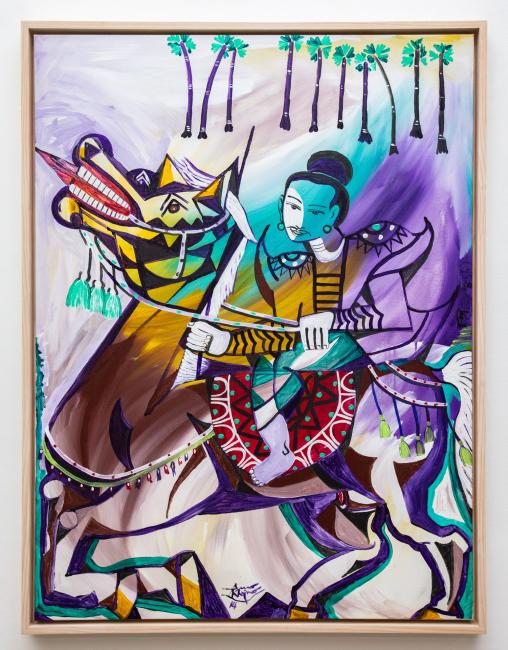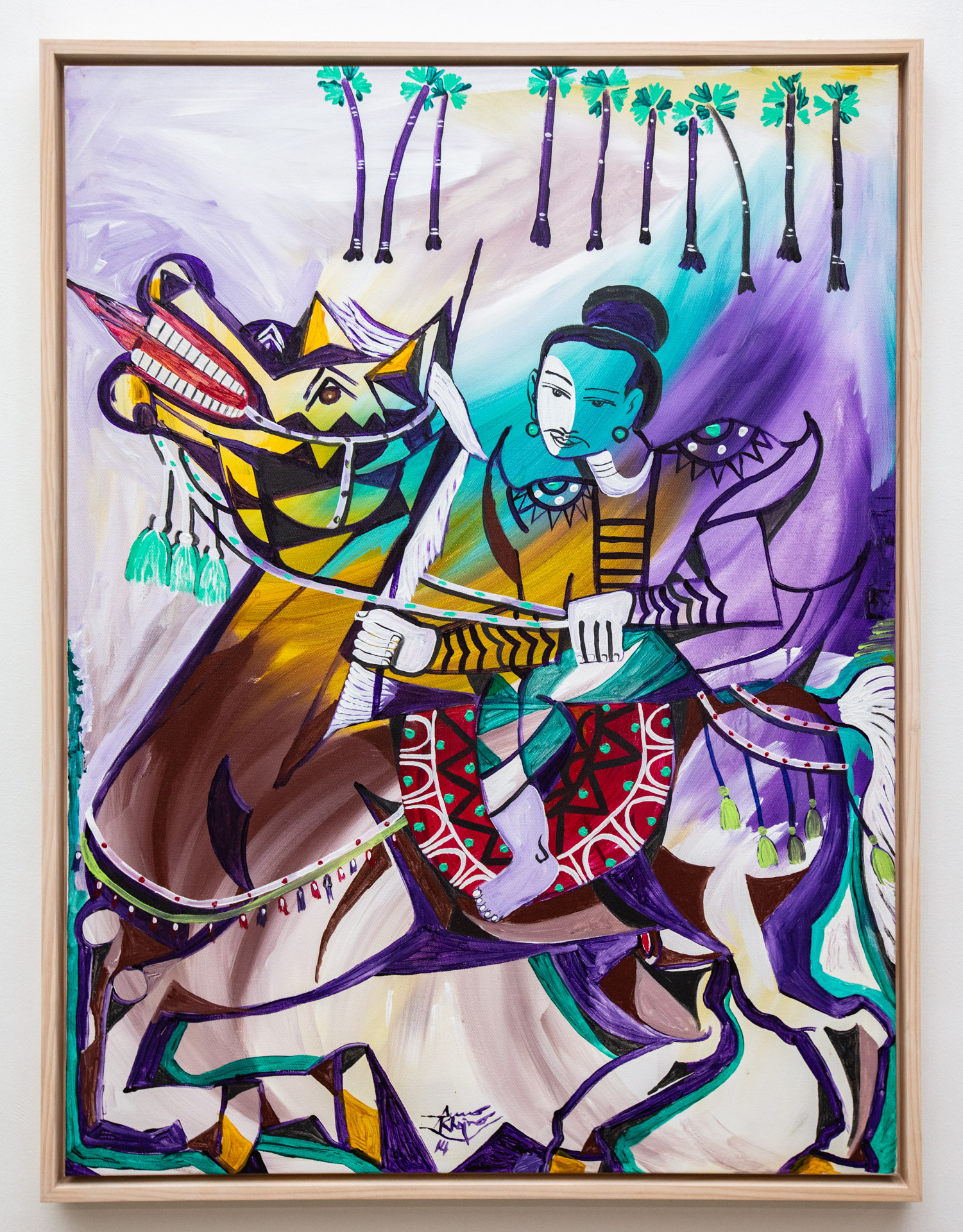Artwork Details
Kogyi Kyaw Nat (Min Kyawzwa Nat)
Credit Line: Gift of Ian Holliday 2023, Collection of SMU
This artwork is part of 25x25 Campus Art Tour.
Listen to the audio description of the artwork here.
Transcript:
Against a background composed of swirling Fauvism colours of varying shades of purple, green and yellow, is a heroic-looking man in the dress and style that suggest a timeless past. He sits astride a horse bedecked in tassels and garlands. The horse's head is pointed up, its row of straight teeth baring aggressively. Geometric patterns within the horse's head point to the influence of Cubism. The artist Aung Khaing, born 1945 in Yangon, is a self-taught artist whose early lessons came via books on Western Modernism as well as Burmese pioneer modernists Aung Soe and Maung Ngwe Tun. The influence of 20th century modernism is clear in his stylistic references, and especially in the homage to Picasso's Cubist horse from his 1937 painting Guernica.
The man on the horse is Min Kyawzwa Nat, also known as Kogyi Kyaw Nat, the spirit guardian of drunkards and gamblers. He is one of the Thirty-Seven Nats from the official pantheon. Nats are spirits believed to be historical humans who suffered violent deaths, and become revered and appropriated for assistance in worldly matters. This system of spirit worship predates Buddhism in Myanmar, and is associated with ancient animist beliefs. Nat shrines are a common sight in banyan trees, while Nat festivals involve a spirit medium, loud music and frenzied dancing.
Aung Khaing has painted a complete series of the Thirty-Seven Great Nats. He merges the identifiable traditional iconographic attributes with his modernist sensibilities, creating an anachronistic image that reflects the syncretic practice of the continued worship of Nats in the Buddhist country.
--
Aung Khaing's is the story of an artistic career interrupted by decades of repression. Emerging in the late 1960s with modernist aspirations, the artist's attempt for a solo exhibition was thwarted by censorship authorities in 1984. Thirty years later in 2013, his first solo exhibition debuted the Burmese Dancers and Puppets series, for Aung Khaing a bitterly symbolic theme.
The Nats series followed with Aung Khaing's second solo exhibition in 2014. The series features the Burmese pantheon of Great Nats, spirits believed to be historical humans who suffered violent deaths and as lost souls both feared and revered. While faithful to their respective iconographic attributes, the Nats were worked with Fauvist abandonment in wild colours and undisguised brushwork. Aung Khaing's stylistic references to 20th century modernism is no clearer than in Kogyi Kyaw Nat (2014) homage to Picasso's Cubist horse from Guernica (1937).
Nearly fifty years after he first set out to make modernist art, Aung Khaing seizes the changed environment to assert his modernist art identity and in the surfeit of possibilities, creates an odd Cubist-Fauvist animal a century after the Modernist avant garde. With the scars of civil and artistic repression still fresh, this anachronism can be explained as Aung Khaing's way of reclaiming his modernist identity and the wrested freedom of self-expression.
In grafting Modernism's formal language to the Nats theme, Aung Khaing's appeal to Burmese identity via traditionalism attracts concomitant enquiries on context-specific attitudes that could point at symbolic content in the Nats series. Although widely practised by Burmese Buddhists, Nat worship remains the controversial profane underbelly of the Buddhist country.
Aung Khaing (b. 1945, Yangon) is a self-taught artist whose early lessons came via books on Western Modernism and Burmese pioneer modernists Aung Soe (1924-1990) and Maung Ngwe Tun (1935-1992).
The SMU Art Collection has over 300 paintings from Myanmar donated by Ian Holliday. A specialist in Burmese politics, Holliday assembled the Thukhuma Collection which comprises of Burmese paintings largely dating from the transitional decade of the 2010s, presenting multiple artistic perspectives on a society in reform. On display at School of Social Sciences and Li Ka Shing Library, the gifted paintings depict the people, culture and land, from the streets of Yangon and rural peripheries to political icons and indigenous deities.

